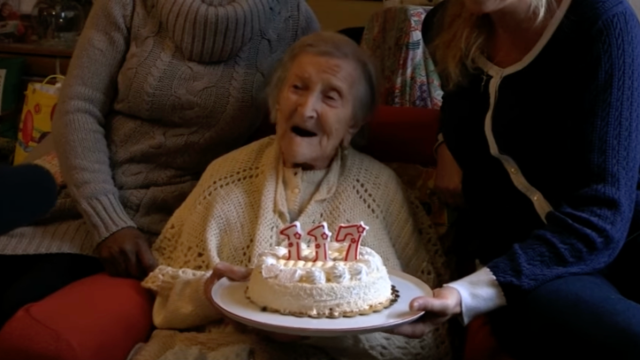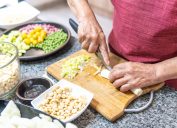117-Year-Old Woman Ate the Same Thing Every Day Since WWI
Believe it or not, her century-long diet didn't involve fruits and vegetables.
For most of us, variety is the spice of life, especially when it comes to what we eat every day. We like to try new restaurants and recipes, looking for a new taste that really wows us. With that in mind, the idea of eating the same thing daily may not sound all that appealing, but some people swear by it. In fact, Emma Morano—who once held the record for being the oldest person alive—said she'd maintained the same diet since World War I, and she certainly believed it worked out in her favor.
RELATED: 116-Year-Old Woman With No Major Health Issues Reveals Her Longevity Diet.
Morano, who was born on Nov. 29, 1899, in Civiasco, Italy, passed away at age 117 in April 2017, BBC reported. Before she died, she spoke with several news outlets about her longevity diet, which may not be what you'd expect.
Every day for 90 years, Morano said she ate three eggs, two of which were raw. She'd been doing so since she was diagnosed with anemia just after WWI, per the BBC.
"The main feature is that she always eats the same things every day, every week, every month of every year," her doctor of 27 years, Carlo Bava, told 5 News in Nov. 2016, adding that she'd always eaten very few fruits and vegetables.
Speaking with AFP News Agency, Cava specified that Morano ate the two raw eggs in the morning, an omelet at noon, and chicken for dinner, BBC reported. Morano also told AFP News Agency that in her later years, she introduced cookies to her diet. (However, when she lost her teeth, she said she wasn't able to eat much of anything.)
While studies have come to different conclusions about the effect of eggs on longevity—with some finding it reduces mortality, and others arguing that it increases mortality—researchers have a clearer understanding of the association between genetics and longer lives. With Morano's family history, genetics were clearly a factor: One of her seven siblings died just before reaching 100, while another lived to be 102, she told The New York Times in 2015. The BBC also reported that her mother lived to be 91.
"We do know that the ability to make it to 110 is heritable, so you have a large increase in chance if you have several people in your family to live to a late age," Valter D. Longo, PhD, director of the Longevity Institute at the University of Southern California, told the NYT regarding Morano.
RELATED: People Who Live to 100 Eat the "World's Healthiest Breakfast," Researcher Says.
In addition to her longevity diet, Morano believed her supercentenarian status was the result of her lifestyle choices. She said she'd previously been in love with a boy who died in WWI, and after that, she didn't have an interest in any suitors. However, her future husband didn't give her much of a choice.
"He told me: 'If you're lucky you marry me, or I'll kill you.' I was 26 years old. I got married," Morano told Italian newspaper La Stampa in 2011.
She later told the NYT that she ended her unhealthy marriage back in 1938, after the death of her six-month-old son. From that point on, she remained single.
"I didn't want to be dominated by anyone," she told the outlet.
Perhaps another explanation for her long life was her move from Villadossola, Italy, to Verbania, after a doctor recommended she relocate for her health.
"The doctor told me to change air, and I'm still here," she told the NYT. Morano also worked in a factory making jute sacks for several decades, news outlets reported.
Best Life offers the most up-to-date information from top experts, new research, and health agencies, but our content is not meant to be a substitute for professional guidance. When it comes to the medication you're taking or any other health questions you have, always consult your healthcare provider directly.
- Source: International Journal Environmental Research and Public Health: Frequency of Egg Intake Associated with Mortality in Chinese Adults: An 8-Year Nationwide Cohort Study
- Source: PLOS Medicine: Egg and cholesterol consumption and mortality from cardiovascular and different causes in the United States: A population-based cohort study






















